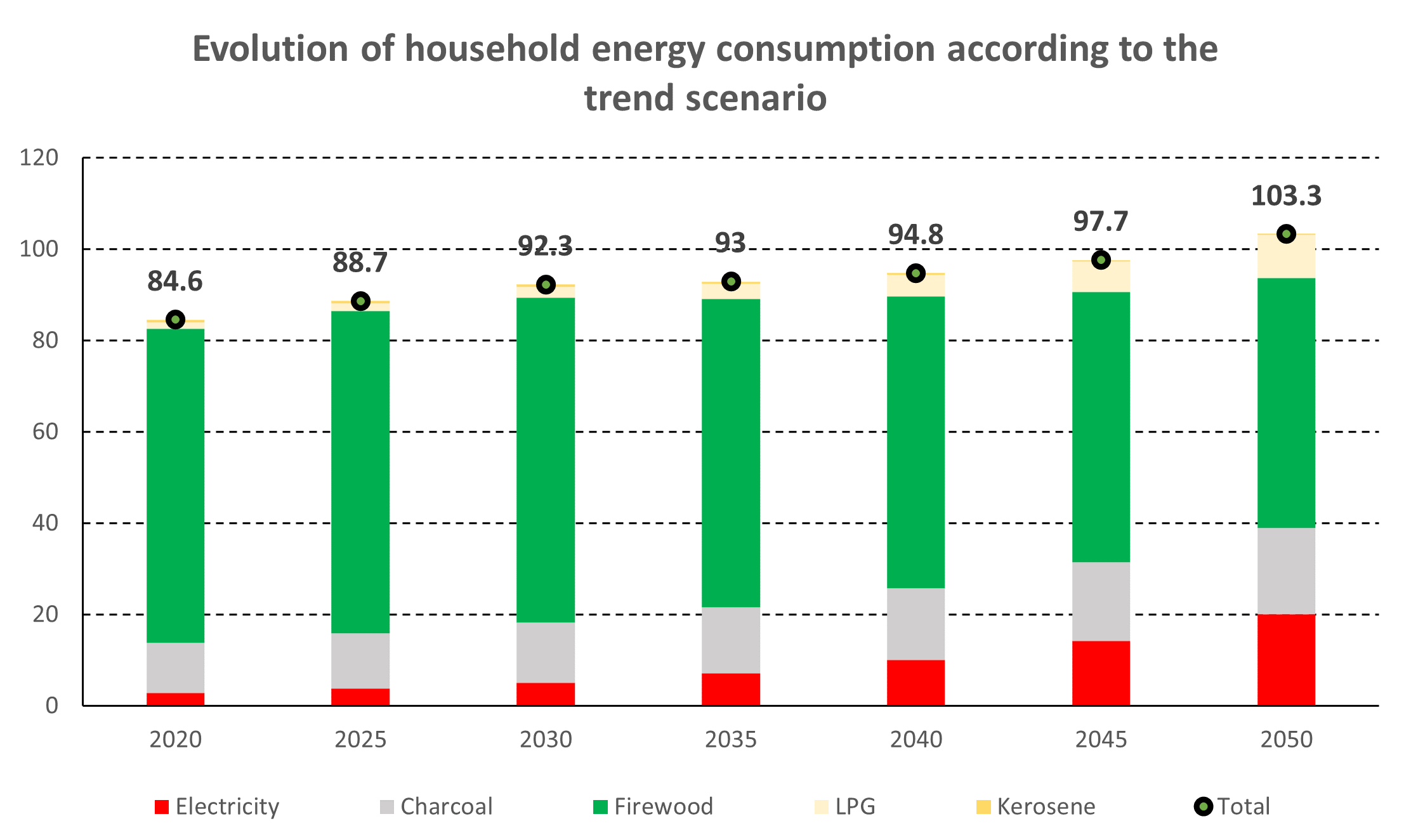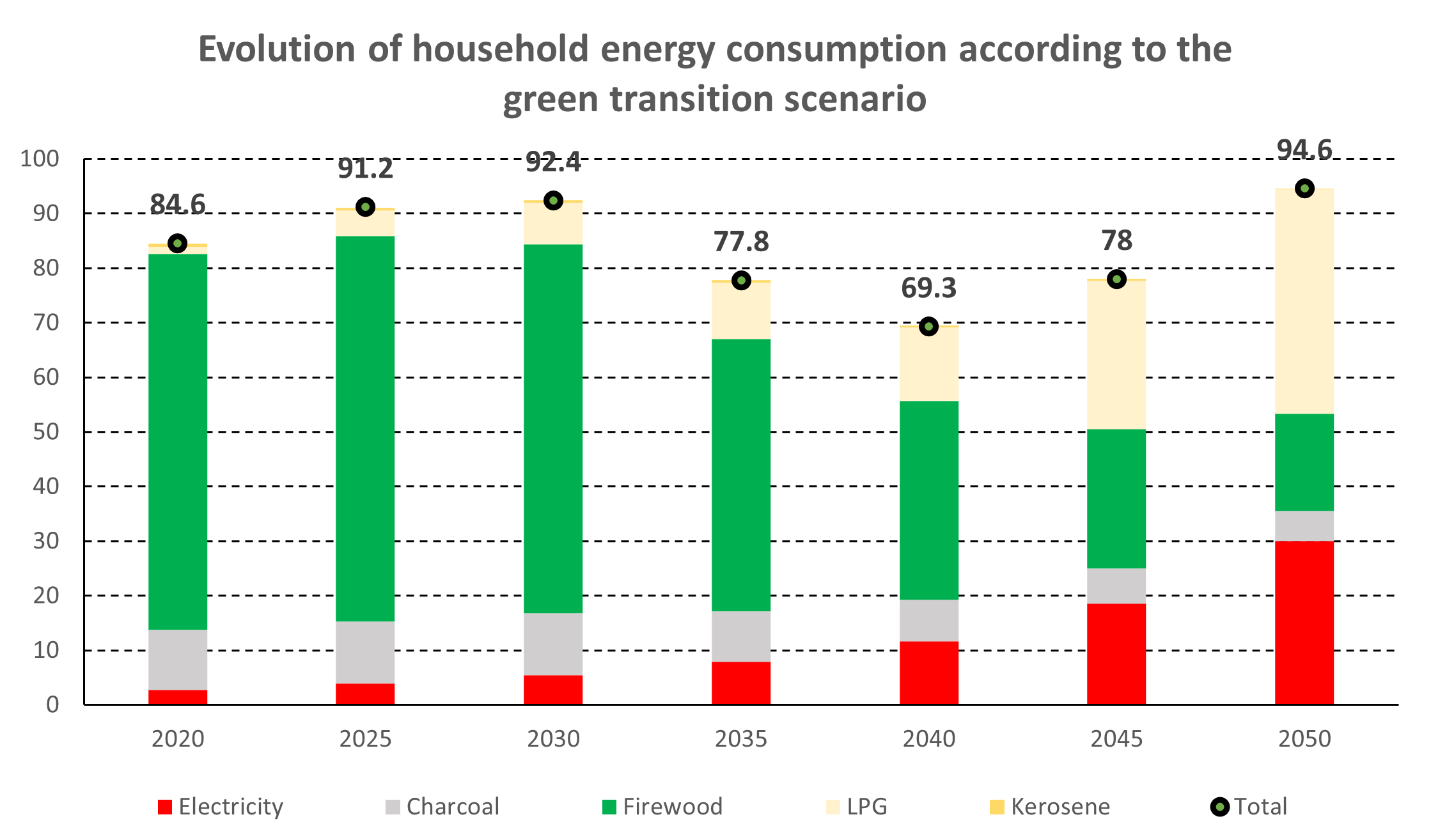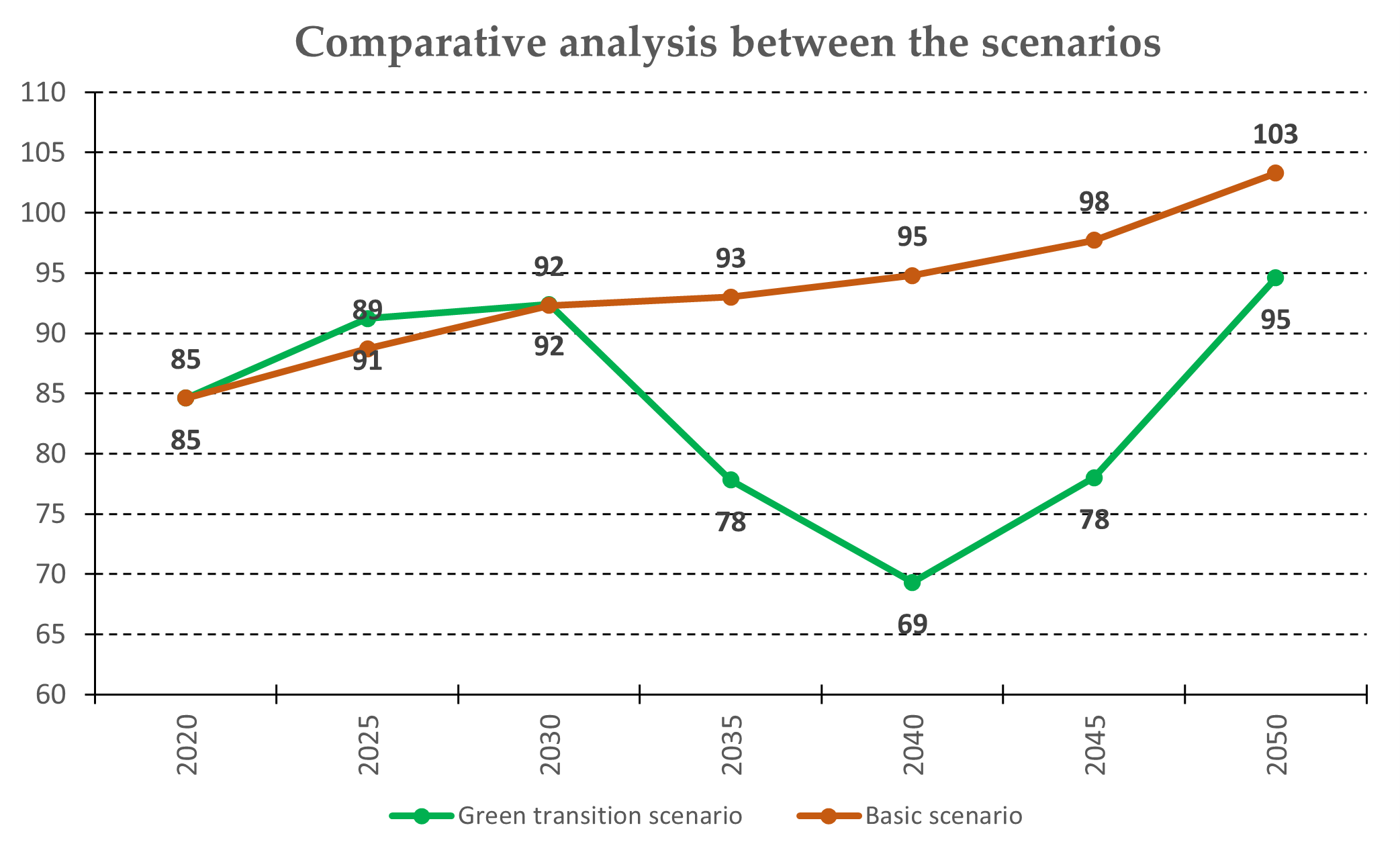Household Energy Outlook 2020-2050 in the ECOWAS Area
This article, based on the results of the ECOWAS Energy Policy Study, presents the forecast of energy consumption in the household sector under two scenarios: the trend scenario and the energy transition scenario.
The residential sector is now the main energy consumption sector in the ECOWAS region. In 2019 (reference year), this sector accounted for more than 60% of the region's final energy consumption. This consumption is about 4 times higher in rural areas than in urban areas due to the high use of wood fuels for cooking in rural areas.
The demographic assumption is that in 2050, more than half a billion ECOWAS inhabitants will reside in cities, more than double that of 2025 despite a slowdown in population growth from 2040 onwards. By 2025, the urban population will be higher than the rural population.
According to the AfDB, the real GDP growth rate over the last 5 years has averaged between 3.5 and 3.6% per year, although there are large disparities between countries. In 2019, the growth rate was 3.6%. The AfDB's projections show that this rate is likely to accelerate from 2022 onwards. These rates are expected to increase by 1% per year between 2020 and 2040 to consider the dynamics of West African economies and by 0.5% from 2040.
Forecasting household energy consumption under the trend scenario
The trend or reference scenario (REF) will extend the current trend but also hold up against the changes underway without major government intervention.
By 2050, total final consumption of households will reach 103 Mtoe, of which 45% will be for urban households and 55% for rural households. Compared to the reference year, the distribution has changed significantly. In 2019, total household consumption was 83.8 Mtoe distributed at 24% for urban households and 76% for rural households. Differentiated demography and the decline in wood consumption in rural areas are the main determinants of the redistribution of consumption between urban and rural areas.

Evolution of household energy consumption according to the trend scenario (Mtoe)
The total final consumption of urban households will be multiplied by 2.7 between the reference year and 2050, with however significant differences according to the forms of energy that reflect access to modern forms of energy. The consumption of kerosene, already extremely low in 2019 (0.8% of final consumption), will be negligible from 2030 with less than 0.5% of total final consumption. Household final electricity and LPG consumption will be multiplied by 7.7 and 7.4 respectively between 2019 and 2050 and will reach 16 Mtoe and 17 Mtoe, i.e. average annual growth rates of 6.8% and 6.7% respectively between 2019 and 2050. Charcoal will be multiplied by a factor of 1.7 equivalent to an increase rate of 1.8% while the share of fuelwood will decrease in absolute and relative values.
Evolution of energy consumption of urban households by form of energy (Mtoe)
|
|
2020 |
2025 |
2030 |
2035 |
2040 |
2045 |
2050 |
|
Electricity |
2.2 |
3.0 |
4.1 |
5.8 |
8.1 |
11.4 |
16.0 |
|
Charcoal |
9.9 |
10.9 |
11.9 |
13.0 |
14.2 |
15.6 |
17.0 |
|
Fuelwood |
3.4 |
3.5 |
3.3 |
3.1 |
2.8 |
2.6 |
2.4 |
|
GPL |
1.2 |
1.6 |
2.2 |
3.1 |
4.4 |
6.1 |
8.6 |
|
Kerosene |
0.1 |
0.1 |
0.1 |
0.1 |
0.1 |
0.1 |
0.1 |
|
Total |
16.9 |
19.1 |
21.7 |
25.1 |
29.6 |
35.8 |
44.0 |
In rural areas, the total final consumption of all forms of energy will decrease due to migration from rural to urban areas. However, the decline in consumption will concern traditional energies. In absolute values, wood will fall from 65.1 Mtoe in 2019 to 52.4 Mtoe in 2050, i.e. an annual decrease rate of -0.7% over the period 2019-2050 (Figure 9). Charcoal will grow at a rate of 1.8% during the target period. On the other hand, the share of LPG and electricity will increase sharply in relative values with rates of 6.9% and 6.8% respectively, reflecting better access to modern fuels. However, the absolute level of modern energy in 2050 will remain low compared to traditional energies.
Evolution of energy consumption of rural households by form of energy (Mtoe)
|
|
2020 |
2025 |
2030 |
2035 |
2040 |
2045 |
2050 |
|
Electricity |
0.6 |
0.8 |
1.0 |
1.4 |
2.0 |
2.8 |
4.0 |
|
Charcoal |
1.1 |
1.2 |
1.3 |
1.4 |
1.5 |
1.7 |
1.9 |
|
Fuelwood |
65.4 |
67.1 |
67.8 |
64.4 |
61.0 |
56.5 |
52.4 |
|
GPL |
0.1 |
0.1 |
0.2 |
0.3 |
0.4 |
0.6 |
0.8 |
|
Kerosene |
0.5 |
0.4 |
0.4 |
0.3 |
0.3 |
0.2 |
0.2 |
|
Total |
67.7 |
69.6 |
70.6 |
67.9 |
65.2 |
61.9 |
59.3 |
The share of fuelwood will decrease over the period 2019-2050. Thus, wood will represent 88% of final consumption in 2050 against 97% in 2019. Charcoal will grow by 1.8% over the same period. The final consumption of electricity and LPG of rural households will be multiplied by a factor of 8 respectively between 2019 and 2050 and will reach 4 Mtoe and 0.8 Mtoe, i.e. average annual growth rates of 6.8% and 6.9% respectively between 2019 and 2050.
The energy dynamics according to the trend scenario show that urban demand will grow strongly over the period 2019-2050, particularly that of modern energies. The relative share of charcoal will, however, decrease in absolute values. Charcoal consumption will increase in rural areas despite a high rate of growth in modern energies. Fuelwood will account for more than 88% of final consumption. The pressure on the forest resource, far from being alleviated, will be increased. In addition, the rate of access to modern energy in rural areas will remain very low. The new policy implies an accelerated substitution of modern energies for traditional energies, particularly in rural areas, and the implementation of accompanying measures.
Forecasting household energy consumption under the Green Transition Scenario (Transgreen)
The green transition scenario integrates countries' policies and strategies as well as their international commitments as part of actions to limit greenhouse gas emissions. The assumptions made are in line with the guidelines, principles, and foundations of regional energy policy, i.e. greater energy security and more balanced energy mixes, compatible with economic, social, and environmental development.
In the Green Energy Transition scenario, access rates to electricity and modern cooking fuels will be higher than in the reference scenario to consider the current large spatial disparity. Final consumption in the green consumption scenario makes it possible to achieve the economic and social objectives of the Member States of the region, the availability of clean and modern energy at an affordable cost, the development of renewable energies, the improvement of energy efficiency, the reduction of GHGs and the securing of the energy supply of the Member States.
By 2050, the household energy mix will undergo profound structural changes that will result in better access to electricity and clean energy for cooking, including LPG. The consumption of traditional energy (fuelwood and charcoal) will fall sharply, which will reduce forest withdrawals for energy uses. However, conservation policies will be essential for some particularly fragile forest basins. Total household final consumption will reach 94 Mtoe, a decrease from the reference scenario (9 Mtoe). This is due to greater access to more energy-efficient forms of energy, and consequently, lower energy consumption for the same service. Disparities in access between rural and urban areas will be reduced.

In 2050, the final consumption of urban households will reach 56.5 Mtoe, i.e. an average growth rate of 4.1% per year over the period, although there will be great disparities according to the forms of energy (see following graphs and tables). The respective growth rates of electricity and LPG will be 8% and 10.9% while charcoal and wood will experience negative rates of -2.8% and -3.1%. The decrease in the consumption of traditional forms of energy is explained by the insertion of modern forms of energy.
Evolution of energy consumption of urban households by form of energy (Mtoe)
|
|
2020 |
2025 |
2030 |
2035 |
2040 |
2045 |
2050 |
|
Electricity |
2.2 |
3.1 |
4.3 |
6.0 |
8.7 |
13.9 |
22.4 |
|
Charcoal |
9.9 |
10.2 |
10.0 |
7.9 |
6.3 |
5.0 |
4.0 |
|
Fuelwood |
3.4 |
3.5 |
3.3 |
2.6 |
2.1 |
1.6 |
1.3 |
|
GPL |
1.2 |
2.6 |
3.8 |
7.2 |
10.7 |
19.7 |
28.7 |
|
Kerosene |
0.1 |
0.1 |
0.1 |
0.1 |
0.1 |
0.1 |
0.0 |
|
Total |
16.9 |
19.5 |
21.4 |
23.8 |
27.8 |
40.3 |
56.5 |
The energy transition will result in an energy mix where modern forms of energy are predominant. Traditional energies will fall sharply in relative value but also in absolute terms, which is the most relevant indicator in terms of pressure on forest resources. In 2050, wood and charcoal will represent only 9.3% of the energy mix while in 2019, this share was close to 80%.
Structure of the energy mix of urban households (%)
|
|
2020 |
2050 |
|
Electricity |
12.6 |
39.7 |
|
Charcoal |
58.9 |
7.0 |
|
Fuelwood |
20.8 |
2.3 |
|
GPL |
7.0 |
50.9 |
|
Kerosene |
0.8 |
0.1 |
In rural areas, the total final consumption of all forms of energy will decrease, due to migration from rural to urban areas and the integration of modern energy with a highly high energy efficiency. Also, the decline in the final consumption of rural households will concern traditional energies. In absolute terms, wood will fall from 65.1 Mtoe in 2019 to 16.6 Mtoe in 2050, i.e. an annual decrease rate of -4.3% over the period 2019-2050. Charcoal will grow at a rate of 1% over the same period. On the other hand, the share of LPG and electricity will increase sharply in relative values with rates of 16.8% and 9% respectively reflecting better access to modern fuels. The exceedingly high growth rates of LPG consumption are also explained by the extremely low absolute level in 2019.
Evolution of energy consumption of rural households by form of energy (Mtoe)
|
|
2020 |
2025 |
2030 |
2035 |
2040 |
2045 |
2050 |
|
Electricity |
0.6 |
0.8 |
1.2 |
1.9 |
2.9 |
4.7 |
7.6 |
|
Charcoal |
1.1 |
1.2 |
1.3 |
1.4 |
1.4 |
1.4 |
1.5 |
|
Fuelwood |
65.4 |
67.1 |
64.3 |
47.2 |
34.3 |
23.9 |
16.6 |
|
GPL |
0.1 |
2.1 |
3.8 |
3.2 |
2.7 |
7.5 |
12.3 |
|
Kerosene |
0.5 |
0.4 |
0.4 |
0.3 |
0.3 |
0.2 |
0.2 |
|
Total |
67.7 |
71.7 |
71.0 |
54.0 |
41.5 |
37.7 |
38.1 |
The energy dynamics according to the green transition scenario show that the energy mix will be profoundly modified with respectively 20% for electricity, 32% for LPG and 47% for traditional energies in 2050. However, despite a fourfold division, wood energy consumption will be 16.6 Mtoe and will account for 43% of total final consumption in 2050. Compared to the baseline scenario, the gains (about 36 Mtoe saved in 2050 alone) are nevertheless substantial. The comparison of the two scenarios over the period 2019-2050 shows that the primary wood saved will be considerable.
Benchmarking between trend scenarios and green transition
Between 2020 and 2030, the energy consumption of households in the tendanciel scenario is less important than that of the green transition scenario because over this period the fuelwood consumption of the two scenarios is quite close while the LPG consumption of the green transition scenario is quite close while the LPG consumption of the green transition scenario is up to 3 times larger than that of the trend scenario.

The implementation of the strategies of the energy transition scenario will allow a saving of about 315 million tonnes of oil equivalent between 2020 and 2050. Electricity and LPG consumption in the energy transition scenario will increase by about 70 Mtoe and 316 Mtoe respectively compared to the trend scenario, but consumption of charcoal, fuelwood and kerosene will decrease by about 173 Mtoe respectively, 522 Mtoe and 0.3 Mtoe.
